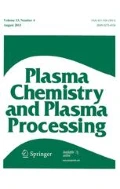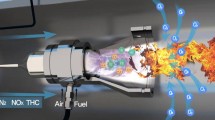Abstract
Combustion provides about 80% energy for our daily life and industrial production. But thermal efficiency of traditional combustion technologies is low, which causes energy waste and serious environmental pollution. In order to improve the combustion efficiency, a combined method based on non-equilibrium plasma generated by dielectric barrier discharge and OH radicals coming from water-steam additive was proposed in this work, and plasma assisted propane combustion was examined and evaluated. The results indicated that when relative humidity (RH) was 20% and applied peak voltage was fixed at 8.75 kV, the relative intensity of OH radical and the flame temperature reached the maximum value at the flame root. At the same time, propane combustion was the most complete. In addition, we found that the erosion of the inner electrode was weakened by H2O addition, and the symmetry of discharge current was changed from symmetry to asymmetry with the increase of RH. Compared with the pure air undischarged combustion, when the relative humidity was 20% and under the discharge conditions of 8.75 kV, the lean-burn extinction limit was extended to 0.4,which is far lower than the traditional lean-burn limit (0.51).
















Similar content being viewed by others
References
Turns SR (2015) An introduction to combustion: concepts and applications, 3rd edn. McGraw-Hill Education and Tsinghua University Press, Beijing
Ju Y, Sun W (2015) Plasma assisted combustion: dynamics and chemistry. Prog Energy Combust Sci 48:21–83. https://doi.org/10.1016/j.pecs.2014.12.002
Pilla G, Galley D, Lacoste DA, Lacas F, Veynante D, Laux CO (2006) Stabilization of a turbulent premixed flame using a nanosecond repetitively pulsed plasma. IEEE Trans Plasma Sci 34:2471–2477
Guo H, Smallwood GJ, Liu F, Ju Y, Gülder ÖL (2005) The effect of hydrogen addition on flammability limit and NOx emission in ultra-lean counterflow CH4/air premixed flames. Proc Combust Inst 30(1):303–311. https://doi.org/10.1016/j.proci.2004.08.177
Shiraishi T, Kakuho A, Urushihara T, Cathey C (2009) A study of volumetric ignition using high-speed plasma for improving lean combustion performance in internal combustion engines. SAE Int J Eng 1:399–408
Giorgi MGD, Sciolti A, Campilongo S, Pescini E, Ficarella A, Martini LM, Tosi P, Dilecce G (2015) Plasma assisted flame stabilizationin a non-premixed lean burner. Energy Proc 82(410–416):410–416. https://doi.org/10.1016/j.egypro.2015.11.825
Varella RA, Sagás JC, Martins CA (2016) Effects of plasma assisted combustion on pollutant emissions of a premixed flame of natural gas and air. Fuel 184:269–276. https://doi.org/10.1016/j.fuel.2016.07.031
Starikovskiy A, Aleksandrov N (2011) Plasma-assisted ignition and combustion. InTech 39:61–110
Li H-Y, Huang P-H, Chao Y-C (2016) Flame enhancement by microwave-induced plasma: the role of major Bath gas N2 Versus Ar. Combust Sci Technol 188(11–12):1831–1843. https://doi.org/10.1080/00102202.2016.1215104
Sekiguchi H, Mori Y (2003) Steam plasma reforming using microwave discharge. Thin Solid Films 435(1–2):44–48. https://doi.org/10.1016/s0040-6090(03)00379-1
Moon SY, Choe W, Kang BK (2004) A uniform glow discharge plasma source at atmospheric pressure. Appl Phys Lett 84(2):188–190. https://doi.org/10.1063/1.1639135
Kovačević VV, Dojčinović BP, Jović M, Roglić GM, Obradović BM, Kuraica MM (2017) Measurement of reactive species generated by dielectric barrier discharge in direct contact with water in different atmospheres. J Phys D Appl Phys 50(15):155205. https://doi.org/10.1088/1361-6463/aa5fde
Tang J, Zhao W, Duan Y (2010) In-depth study on propane–air combustion enhancement with dielectric barrier discharge. IEEE Trans Plasma Sci 38(12):3272–3281
Tang J, Zhao W, Duan J, Duan Y (2011) Nonequilibrium plasmas generated by dielectric barrier discharges at atmospheric pressure. IEEE Trans Plasma Sci 39:2080–2081
Tang J, Zhao W, Duan Y (2011) Some observations on plasma-assisted combustion enhancement using dielectric barrier discharges. Plasma Sources Sci Technol 20(4):045009. https://doi.org/10.1088/0963-0252/20/4/045009
Kang Y, Wu Z (2008) Formation of hydroxyl radicals and oxidation of toluene under corona discharge with water vapor as radical source. Sci Bull 53(14):2248–2252. https://doi.org/10.1007/s11434-008-0292-7
Starikovskii AY (2005) Plasma supported combustion. Proc Combust Inst 30(2):2405–2417. https://doi.org/10.1016/j.proci.2004.08.272
Das AK, Kumar K, Sung C-J (2011) Laminar flame speeds of moist syngas mixtures. Combust Flame 158(2):345–353. https://doi.org/10.1016/j.combustflame.2010.09.004
Santner J, Dryer FL, Ju Y (2013) The effects of water dilution on hydrogen, syngas, and ethylene flames at elevated pressure. Proc Combust Inst 34(1):719–726. https://doi.org/10.1016/j.proci.2012.06.065
Wang P, Zhao Y, Chen Y, Bao L, Meng S, Sun S (2017) Study on the lower flammability limit of H2/CO in O2/H2O environment. Int J Hydrogen Energy 42(16):11926–11936. https://doi.org/10.1016/j.ijhydene.2017.02.143
Xie Y, Wang J, Xu N, Yu S, Huang Z (2014) Comparative study on the effect of CO2 and H2O dilution on laminar burning characteristics of CO/H2/air mixtures. Int J Hydrogen Energy 39(7):3450–3458. https://doi.org/10.1016/j.ijhydene.2013.12.037
Su Z-Z, Ito K, Takashima K, Katsura S, Onda K, Mizuno A (2002) OH radical generation by atmospheric pressure pulsed discharge plasma and its quantitative analysis by monitoring CO oxidation. J Phys D Appl Phys 35:3192–3198
Larionov VM, Mitrofanov GA, Sachovskii AV, Kozar NK (2016) Mechanism of influence water vapor on combustion characteristics of propane–air mixture. J Phys Conf Ser 669:012041. https://doi.org/10.1088/1742-6596/669/1/012041
Higgins B, McQuay MQ, Lacas F, Rolon JC, Darabiha N, Candel S (2001) Systematic measurements of OH chemiluminescence for fuel-lean, high-pressure, premixed, laminar flames. Fuel 80:67–74
Sun M, Wu Y (2005) Diagnosis of OH radical by optical emission spectroscopy in atmospheric pressure unsaturated humid air corona discharge and its implication to desulphurization of flue gas. Plasma Chem Plasma Process 25:31–40
Yan W, Jie L, Ninghui W, Guofeng L, Dexuan X (2001) Study on increasing the SO2 removal efficiency with the radicals produced by H2O in pulse discharge plasma process. Jpn J Appl Phys 40:838–840
Rosocha LA, Coates DM, Platts D, Stange S (2004) Plasma-enhanced combustion of propane using a silent discharge. Phys Plasmas 11(5):2950–2956. https://doi.org/10.1063/1.1688788
Yao S, Weng S, Tang Y, Zhao C, Wu Z, Zhang X, Yamamoto S, Kodama S (2016) Characteristics of OH production by O2/H2O pulsed dielectric barrier discharge. Vacuum 126:16–23. https://doi.org/10.1016/j.vacuum.2016.01.005
Dai D, Wang Q, Hao Y (2013) Experimental study on asymmetrical period-one discharge in dielectric barrier discharge in helium at atmospheric pressure. Acta Phys Sin 62:13
Falkenstein Z, Coogan JJ (1997) Microdischarge behaviour in the silent discharge of nitrogen–oxygen and water–air mixtures. J Phys D Appl Phys 30:817–825
Xu J, Li C, Zhan H, Li M (2008) Effect of electrode structure on dielectric barrier discharge in air. High Volt Appar 44(2):132–138. https://doi.org/10.13296/j.1001-1609.hva.2008.02.006
Zhang F, Sun Y (2017) Dielectric barrier discharge model study of parallel plate electrodes considering wall charge accumulation. Insul Mater 50(11):50–53. https://doi.org/10.16790/j.cnki.1009-9239.im.2017.11.010
Ding W, He L, Lan Y (2010) Influence of accumulated charges on characteristic of dielectric barrier discharge. High Volt Eng 36(2):456–460. https://doi.org/10.13336/J.1003-6520.HVE.2010.02.002
Zhang Y, Wang D, Kong MG (2006) Complex dynamic behaviors of nonequilibrium atmospheric dielectric-barrier discharges. J Appl Phys. https://doi.org/10.1063/1.2345463
Yan P, Shao T (2015) Atmospheric pressure gas discharge and its plasma applications. The Science Publishing Company, Beijing
Zhang L, Wang B, Dang W (2008) Excited dissociation kinetics of H2O by pulsed streamer discharge. Acta Phys Chim Sin 24:1524–1528
Ono R, Oda T (2003) Dynamics of ozone and OH radicals generated by pulsed corona discharge in humid-air flow reactor measured by laser spectroscopy. J Appl Phys 93(10):5876–5882. https://doi.org/10.1063/1.1567796
Gokulakrishnan P, Fuller CC, Klassen MS, Joklik RG, Kochar YN, Vaden SN, Lieuwen TC, Seitzman JM (2014) Experiments and modeling of propane combustion with vitiation. Combust Flame 161(8):2038–2053. https://doi.org/10.1016/j.combustflame.2014.01.024
Kornev J, Yavorovsky N, Preis S, Khaskelberg M, Isaev U, Chen BN (2006) Generation of active oxidant species by pulsed dielectric barrier discharge in water–air mixtures. Ozone Sci Eng 28(4):207–215. https://doi.org/10.1080/01919510600704957
Oda T (2003) Non-thermal plasma processing for environmental protection: decomposition of dilute VOCs in air. J Electrost 57(3):293–311. https://doi.org/10.1016/S0304-3886(02)00179-1
Nishiyama H, Takana H, Niikura S, Shimizu H, Furukawa D, Nakajima T, Katagiri K, Nakano Y (2008) Characteristics of ozone jet generated by dielectric-barrier discharge. IEEE Trans Plasma Sci 36(4):1328–1329. https://doi.org/10.1109/TPS.2008.924403
Marques CS, Benvenutti LH, Bertran CA (2001) Experimental study of OH*, CHO*, CH*, and C2* radicals in C2H2/O2 and C2H2/O2/Ar flames in a closed chamber. Combust Sci Technol 167(1):113–129. https://doi.org/10.1080/00102200108952179
Docquier N, Candel S (2002) Combustion control and sensors: a review. Prog Energy Combust Sci 28(2):107–150
Marques CST, Benvenutti LH, Bertran CA (2006) Kinetic modeling for chemiluminescent radicals in acetylene combustion. J Braz Chem Soc 17(2):302–315. https://doi.org/10.1590/s0103-50532006000200013
Ju Y, Lefkowitz JK, Reuter CB, Won SH, Yang X, Yang S, Sun W, Jiang Z, Chen Q (2015) Plasma assisted low temperature combustion. Plasma Chem Plasma Process 36(1):85–105. https://doi.org/10.1007/s11090-015-9657-2
Park S-L, Moon J-D, Lee S-H, Shin S-Y (2006) Effective ozone generation utilizing a meshed-plate electrode in a dielectric-barrier discharge type ozone generator. J Electrost 64(5):275–282. https://doi.org/10.1016/j.elstat.2005.06.007
Simek M, Clupek M (2002) Efficiency of ozone production by pulsed positive corona discharge in synthetic air. J Phys D Appl Phys 35:1171–1175. https://doi.org/10.1088/0022-3727/35/11/311
Yamamoto Y, Tachibana T (2016) Feasibility study of water plasma jets for combustion promotion. Fuel 186:846–852. https://doi.org/10.1016/j.fuel.2016.09.020
De Giorgi MG, Ficarella A, Sciolti A, Pescini E, Campilongo S, Di Lecce G (2017) Improvement of lean flame stability of inverse methane/air diffusion flame by using coaxial dielectric plasma discharge actuators. Energy 126:689–706. https://doi.org/10.1016/j.energy.2017.03.048
Acknowledgements
The authors would like to thank the editors and anonymous reviewers for their careful work and thoughtful suggestions that have helped improve this paper substantially.
Author information
Authors and Affiliations
Corresponding author
Rights and permissions
About this article
Cite this article
Li, Y., Niu, G., Wang, X. et al. Effects of Air/H2O Discharge Plasma on Propane Combustion Enhancement Using Dielectric Barrier Discharges. Plasma Chem Plasma Process 38, 831–850 (2018). https://doi.org/10.1007/s11090-018-9896-0
Received:
Accepted:
Published:
Issue Date:
DOI: https://doi.org/10.1007/s11090-018-9896-0



